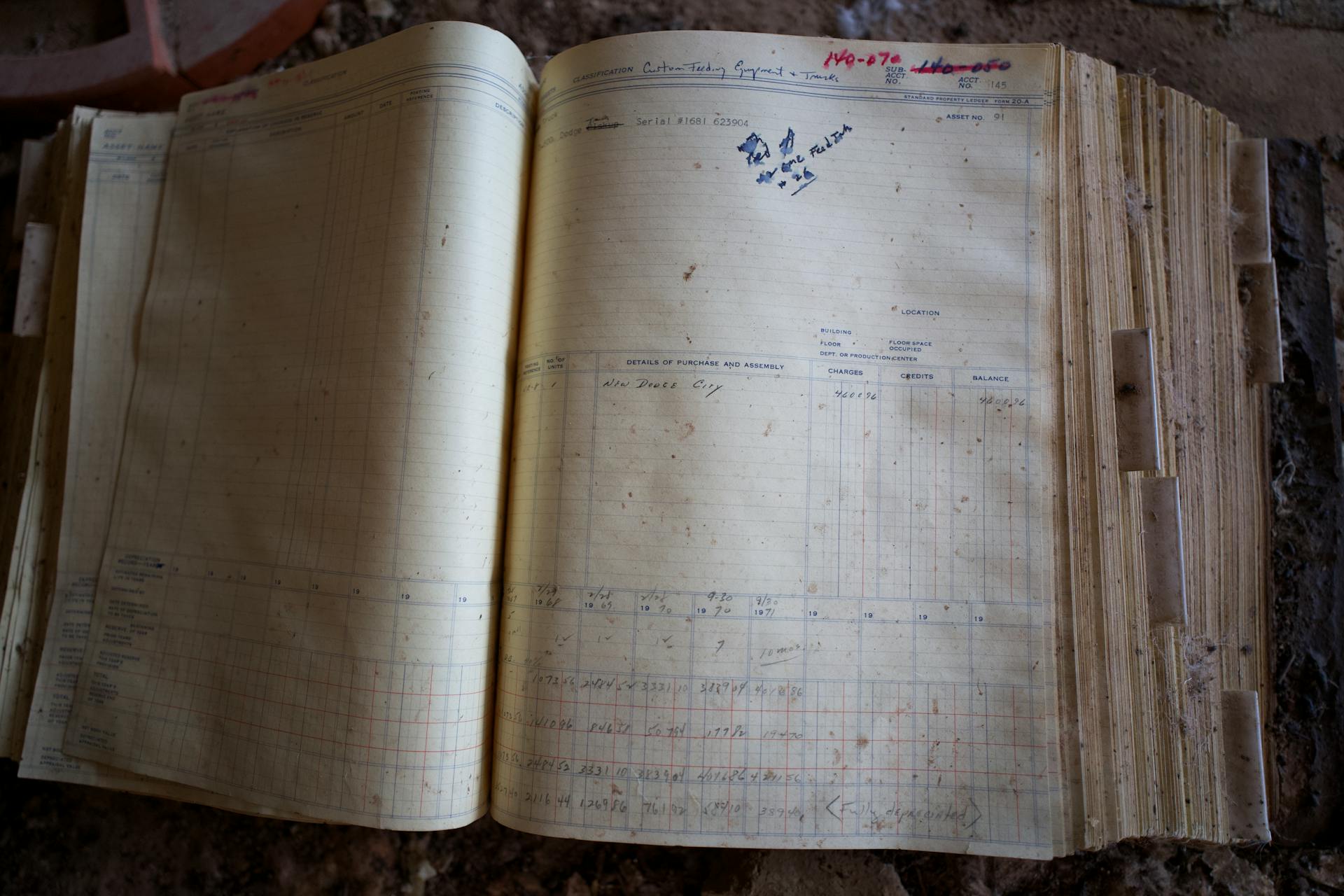
Reconciliation accounting is a process that helps you ensure the accuracy of your company's financial records. It involves comparing your company's financial statements, such as the balance sheet and income statement, with your bank and credit card statements.
To start reconciling your accounts, gather all relevant statements and documents, including your company's financial statements, bank statements, and credit card statements. You'll also need to identify any outstanding transactions that haven't been recorded in your financial statements yet.
The goal of reconciliation accounting is to identify and correct any discrepancies between your financial records and your bank and credit card statements. By doing so, you can ensure that your financial statements accurately reflect your company's financial position and performance.
It's essential to reconcile your accounts regularly, ideally at the end of each accounting period, to catch any errors or discrepancies early on.
Consider reading: Axis Bank Credit Card Statement
What is Reconciliation Accounting?
Reconciliation accounting is a process used to ensure the accuracy and integrity of financial records. It involves comparing three sets of records to verify they are all accurate and consistent.
A three-way reconciliation, also known as a three-way trust reconciliation, is a specific type of reconciliation accounting used by law firms to check that their internal trust ledgers line up with individual client trust ledgers and trust bank statements.
This process helps to ensure accuracy, consistency, transparency, and compliance. By reconciling three sets of records - internal records, client records, and bank statements - discrepancies can be identified and resolved.
The three sets of records to be reconciled are:
- Internal records, specifically the trust account ledgers maintained by the law firm.
- Client records, which are represented by client ledgers.
- Bank statements for the trust account.
Conducting regular three-way reconciliations allows you to uphold your duty to keep proper, accurate accounting records for client funds held in trust, while also ensuring you stay compliant. Your state may have specific requirements for how often you must conduct three-way reconciliation, such as monthly or quarterly.
Related reading: Which Three Activities Are Part of the Function of Accounting
Preparing for Reconciliation
To start the reconciliation process, get your financial records together, including statements for every form of account associated with your business.
You'll want to collect a list of transactions from your bank, as well as your credit card statement and monthly statement.
Additional reading: Brokerage Account Statement
To conduct a three-way reconciliation, you'll need three sets of records: the firm's internal trust account ledger, the client records/client ledgers, and the bank statement for the trust account.
These records can be accessed electronically or in your practice management software.
Take note that you may need to make adjustments due to timing differences, such as transactions that may not yet have cleared the trust bank account.
Here are the three sets of records you'll need:
- The firm’s internal trust account ledger
- The client records/client ledgers
- The bank statement for the trust account
Collect Necessary Documents
Collecting necessary documents is a crucial step in preparing for reconciliation. You'll want to gather all your financial records, including bank statements and accounting software data.
To start, obtain financial records from your bank, which should include a list of transactions for each account associated with your business. This can be as simple as collecting your credit card statement and monthly statement.
Access your accounting software to automatically bring in invoices and receipts, and extract the relevant data. This can be done in a logbook, spreadsheet, or specialized accounting software.
You might like: Hipaa Compliant Accounting Software
You'll need three sets of records for the specified time period: the firm's internal trust account ledger, client records/client ledgers, and the bank statement for the trust account. These records are essential for conducting three-way reconciliation.
Here's a breakdown of the necessary documents:
- The firm's internal trust account ledger
- The client records/client ledgers
- The bank statement for the trust account
Remember to keep an eye out for transactions that may not match immediately between the sets of records, such as undeposited funds. These discrepancies may require adjustments due to timing differences.
By collecting these necessary documents, you'll be well-prepared for the reconciliation process and can ensure accurate financial records.
Examine Your Expenditures
Examine your expenditures carefully, making sure each entry corresponds to a withdrawal from your bank account. If this isn't the case, it's possible that one of your payments hasn't cleared yet, or that you paid with cash or a separate account.
Each entry should be verified to ensure it accurately reflects a withdrawal from your bank account. This helps prevent errors and discrepancies.
For more insights, see: Depreciation Expense Journal Entry

Companies perform accounting reconciliation on a monthly basis to flag potential instances of fraud or theft, and to prevent balance sheet errors. This is especially important in the event of an audit.
You should also consider whether each withdrawal corresponds to a specific transaction, such as a sale or a refund. If something is missing, fill in the blanks to ensure your accounts are accurate.
Account reconciliations are a necessary part of the accounting process, helping businesses identify and prevent errors and discrepancies.
Ensure Timely
To ensure timely reconciliation, it's essential to reconcile accounts frequently. For trust accounts, this typically means reconciling on a monthly basis or as required by your state bar's regulations.
Reconciling general operating accounts on a weekly or even daily basis is usually a good practice. Revenue accounts, which track law firm income, should be reconciled at least monthly.
To give you a better idea, here's a breakdown of the recommended reconciliation frequencies:
By following these guidelines, you can help prevent errors and ensure the accuracy of your financial records.
Reconciliation Process
The reconciliation process is a crucial step in ensuring the accuracy and integrity of your financial records. It involves comparing your general ledger account balances to supporting sets of records and bank statements.
To implement effective reconciliation processes, you need to create and document the exact procedures that staff and lawyers should follow. This includes documenting the step-by-step directions for handling reconciliation for financial records, trust accounts, and other accounts.
Establishing clear processes and procedures is essential in the reconciliation process. You should define who is responsible for each step in the reconciliation process and establish policies for record creation and retention.
The typical steps in the account reconciliation process include comparing your bank statement against your cash book statement, documenting all payment records that appear in the cash book but not in your bank statement, and looking out for any inconsistencies between transactions that show up in both your bank statement and your cash book.
Worth a look: The Direct Method of Reporting Operating Cash Flows
Here are the key steps in the account reconciliation process:
- Compare your bank statement against your cash book statement.
- Document all payment records that appear in the cash book but not in your bank statement.
- Look out for any inconsistencies between transactions that show up in both your bank statement and your cash book.
- Check the bank statement for any possible errors and report them.
- Ensure the balance is equal in both documents.
A three-way trust reconciliation is a process used in accounting to ensure the accuracy and integrity of trust accounts. It involves reconciling three sets of records: the bank statements, the internal accounting records, and the individual client records.
Common Issues and Solutions
Timing differences in recording to the general ledger can cause discrepancies in account reconciliation.
Outstanding and missing transactions are common issues that can arise during the reconciliation process.
Transaction errors, such as duplicate recording of transactions, can also occur and need to be addressed.
Recording an asset as an expense is another type of error that can be identified through account reconciliation.
To prevent discrepancies, prior month's journal entry accruals need to be reversed.
Account reconciliation allows you to identify potential errors like misapplied payments and take action to correct them.
These errors can be eliminated through the account reconciliation process, ensuring accurate financial records.
Best Practices and Tools
Regular reconciliation is key to catching discrepancies before they become major issues. Conduct reconciliations on a regular basis, ideally monthly or as frequently as necessary based on the volume of transactions.
To make the process smoother, maintain detailed documentation of the reconciliation process, including bank statements, invoices, receipts, and other relevant records. This will facilitate future audits or reviews and help identify and resolve discrepancies.
Implementing segregation of duties is also crucial, as it ensures that different individuals are responsible for different aspects of the process, such as recording, reconciling, and approving financial transactions. This separation helps prevent errors and fraud.
Here are some best practices to follow:
- Regular reconciliation: Conduct reconciliations on a regular basis, ideally monthly or as frequently as necessary.
- Documentation and record-keeping: Maintain detailed documentation of the reconciliation process.
- Segregation of duties: Implement segregation of duties to prevent errors and fraud.
Technology can also streamline the reconciliation process, helping to prevent accidental errors and make it easier to stay compliant. Utilize accounting software or reconciliation tools to automate the reconciliation process and reduce manual errors.
Benefits of Reconciliation Accounting
Reconciliation accounting is a crucial process that can help you maintain accurate financial records. By learning how to reconcile accounts, you can identify mistakes such as duplicate payments, missing payments, and calculation errors.
Reconciliation helps you keep track of bank charges and penalties that may not be included already on the books. This can help prevent financial discrepancies and ensure your financial records are up to date.
Regular reconciliation can also detect fraudulent transactions, giving you peace of mind and protecting your business from financial losses.
By monitoring your payables and receivables, you can ensure timely payments and collections, which can help maintain a positive cash flow.
Here are some key benefits of reconciliation accounting:
- Identifying mistakes such as duplicate payments, missing payments, and calculation errors
- Keeping track of bank charges and penalties
- Detecting fraudulent transactions
- Monitoring payables and receivables
Utilize Technology
Technology can streamline the account reconciliation process, prevent accidental errors, and make it easier to stay compliant. Manual reconciliation is more susceptible to human error and can take anywhere from a couple of business days to several weeks, which is why automation is a better option.
Automation software can effectively automate the cash application process for you, eliminating the need for manual data entry and saving you valuable time and effort. This is especially useful when it comes to reconciling cash inflows from accounts receivable.
For your interest: Cash Account vs Margin Account
Some automation software, like Versapay's collaborative AR automation software, combines powerful automation capabilities with tools for collaborating with team members and customers, all in one cloud-based platform. This can help create exceptional customer experiences while achieving efficiency goals, like improving the account reconciliation process.
The use of technology, such as Clio's legal trust management software, can provide lawyers with the ability to conduct trust account reconciliation, helping to keep their firm compliant and their client's funds secure. This can also help to simplify reconciliations and reduce the risk of errors.
Here are some benefits of utilizing technology for account reconciliation:
- Streamlines the process, reducing the risk of errors
- Automates tasks, saving time and effort
- Improves compliance and reduces the risk of fines
- Enhances customer experience and satisfaction
- Increases efficiency and productivity
Easy Three-Way Trust
Easy Three-Way Trust reconciliation is a breeze with the right tools and processes in place. Clio's legal trust management software and Clio Accounting provide lawyers with the ability to conduct trust account reconciliation, keeping firms compliant and client funds secure.
A three-way trust reconciliation involves reconciling three sets of records: bank statements, internal accounting records, and individual client records. This process ensures accuracy and integrity of trust accounts, particularly for law firms holding client funds.
To perform a three-way trust reconciliation, you must compare these three sets of financial records to ensure they're accurate, consistent, and properly recorded. The general steps for this process include aligning individual client ledgers with the firm's trust account ledger and then reconciling the client ledgers and trust account ledgers with the trust bank account statement.
Here's a step-by-step guide to reconciling the trust bank account:
- The bank statement's starting balance should match the internal trust account ledger's starting balance.
- Each transaction on the bank statement should match the corresponding entry for the internal ledger.
- The client records should match both the internal ledger and the trust account bank statement.
- If there are any missing or duplicate transaction records, make any necessary adjustments to the internal ledger.
By following these steps and using the right tools, you can ensure your firm is compliant and your client's funds are secure.
Establish Clear Processes
Establishing clear processes is a crucial step in effective reconciliation. This involves creating and documenting the procedures that staff and lawyers should follow.
You should document the step-by-step directions for your firm to handle reconciliation for financial records, trust accounts, and other accounts. This will help ensure consistency and accuracy in the reconciliation process.
Segregation of duties is essential in the reconciliation process, making sure that different individuals are responsible for different aspects of the process. This separation guarantees that multiple sets of eyes review the financial information at different points in the reconciliation process.
Expand your knowledge: What Are the Different Disciplines within the Accounting Profession
Clear procedures promote consistency, minimize errors, and make sure that the reconciliation process is conducted in an organized manner. Establish standardized reconciliation procedures, clearly defining appropriate steps, roles and responsibilities of individuals, and specific deadlines.
A note on who's responsible for reconciliation: Ultimately, the responsibility to maintain trust compliance, and the consequences of failing to do so, fall onto you as a lawyer, even if staff complete reconciliations on your behalf.
Here are the key steps to create clear processes:
- Document the step-by-step directions for your firm to handle reconciliation.
- Define who is responsible for each step in the reconciliation process.
- Establish policies for record creation and retention.
Business-Specific Considerations
Business-specific considerations are crucial to ensure accurate reconciliation accounting.
Some businesses may need to reconcile employee expenses payable with individual expense reports, such as companies with a field sales team. This requires matching expenses reported by employees with the company's records.
Reconciliations may also involve matching invoices with purchase orders or receipts, or reconciling bank statements with general ledgers.
Intriguing read: Prepaid Expenses Depreciation Expense Accrued Expenses
Business-Specific
Business-specific considerations can be a challenge for companies with unique needs.
In some cases, businesses with a field sales team may need to reconcile employee expenses payable with individual expense reports.

This can be a time-consuming process, but it's essential for maintaining accurate financial records.
Companies with multiple locations or divisions may need to consider reconciliations for each site or department.
These reconciliations can help identify discrepancies and ensure that financial data is accurate and up-to-date.
Businesses with international operations may need to account for different currencies and exchange rates, adding another layer of complexity to their reconciliation process.
Customer
Customer reconciliation is a crucial process where companies compare their outstanding customer balances to the accounts receivable captured in the general ledger to unveil any irregularities in customer-level accounting.
Companies typically perform customer reconciliation before issuing their monthly financial statements. This process helps to ensure the accuracy of customer accounts.
The customer reconciliation statement serves as proof that there’s no material inaccuracy in the accounts.
Vendor
Vendor is a crucial aspect of business operations, and companies must ensure they're working with reliable vendors to avoid discrepancies.
Vendor reconciliation is a process where a company compares the accounts payable in its books with the balance provided in documentation from their vendors, ensuring there are no major discrepancies between the amount a vendor charges and the goods and services the company actually received.
This process helps companies identify and resolve any issues with their vendors, which can save them time and money in the long run.
Intercompany
Intercompany reconciliations are a crucial process for parent companies to unify their subsidiaries' general ledgers. This helps eliminate intercompany flows and minimize bank transaction fees.
A parent company can identify inconsistencies between subsidiaries and unrecorded transactions or balances on the books of group companies through this process.
Expand your knowledge: Intercompany Accounting
Conclusion and Next Steps
Reconciliation in accounting is essential for lawyers and law firms to ensure financial accuracy and compliance. Proper reconciliation is particularly important for managing trust accounts.
Lawyers can save time and reduce errors by leveraging technology for more efficient reconciliation processes. This allows them to focus on other important tasks.
By adopting best practices for process, timeliness, and documentation of reconciliation, law firms can meet their legal and ethical obligations. This includes staying compliant and ensuring the integrity of their financial transactions.
Frequently Asked Questions
What are the 5 steps to reconcile your account?
To reconcile your account, follow these 5 simple steps: Gather bank and business records, identify discrepancies between deposits and income, and match withdrawals with expenses. This process helps you end with a balanced account.
What is the formula for reconciliation?
The formula for reconciliation is: (Last Statement Balance - Checks + Deposits + Interest Income - Bank Charges +/- Other Items) - Current Statement Balance = 0. This equation ensures that your statement is accurately reconciled by balancing all transactions.
Sources
- https://www.portebrown.com/newsblog-archive/how-to-do-bank-reconciliation
- https://stripe.com/resources/more/accounting-reconciliation-101
- https://tipalti.com/resources/learn/account-reconciliation/
- https://www.clio.com/blog/reconciliation-accounting/
- https://www.versapay.com/resources/account-reconciliation
Featured Images: pexels.com


